2022 HYUNDAI TUCSON HYBRID invert
[x] Cancel search: invertPage 20 of 630
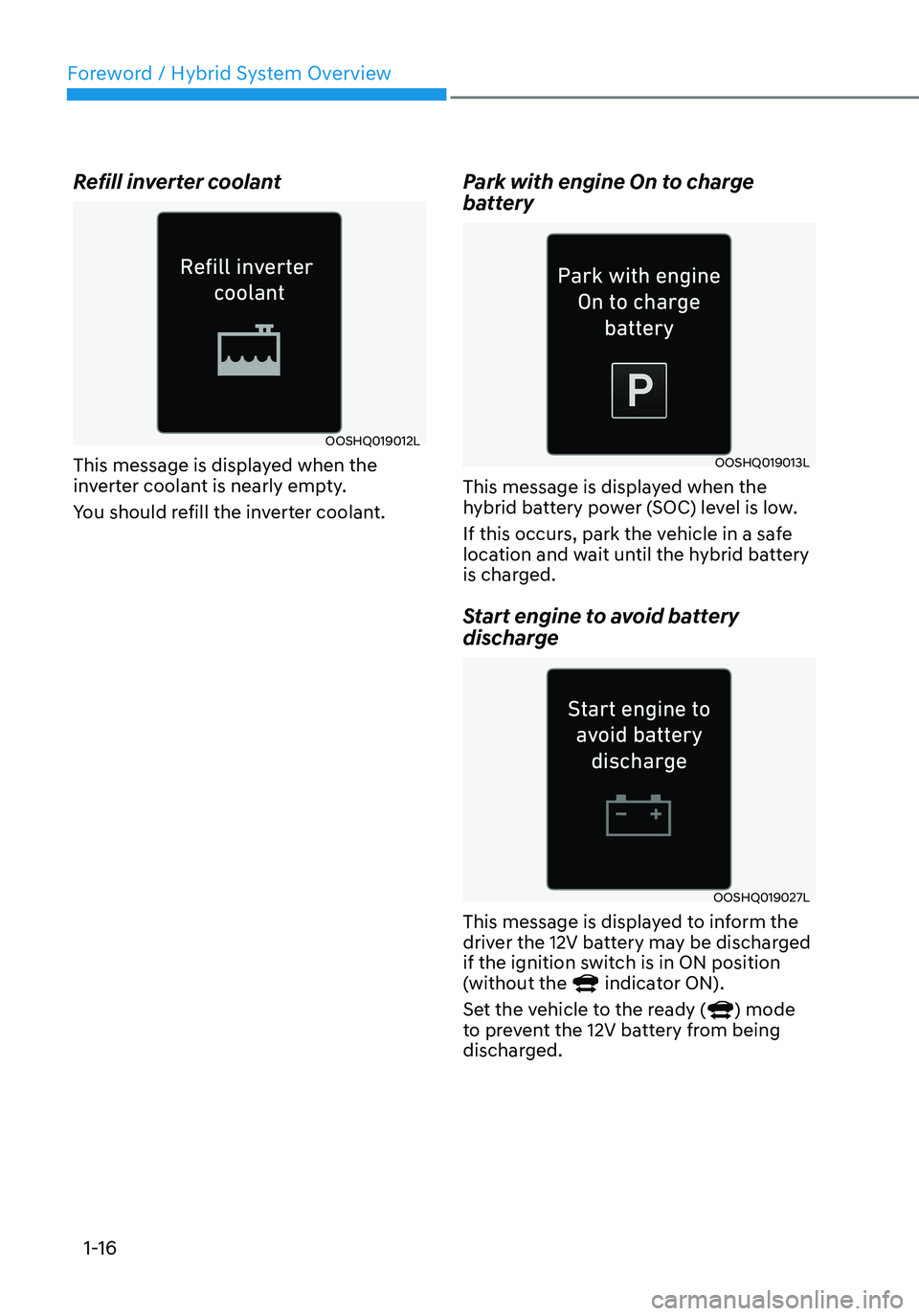
Foreword / Hybrid System Overview
1-16
Refill inverter coolant
OOSHQ019012L
This message is displayed when the
inverter coolant is nearly empty.
You should refill the inverter coolant.
Park with engine On to charge
battery
OOSHQ019013L
This message is displayed when the
hybrid battery power (SOC) level is low.
If this occurs, park the vehicle in a safe
location and wait until the hybrid battery
is charged.
Start engine to avoid battery
discharge
OOSHQ019027L
This message is displayed to inform the
driver the 12V battery may be discharged
if the ignition switch is in ON position
(without the
indicator ON).
Set the vehicle to the ready () mode
to prevent the 12V battery from being
discharged.
Page 26 of 630
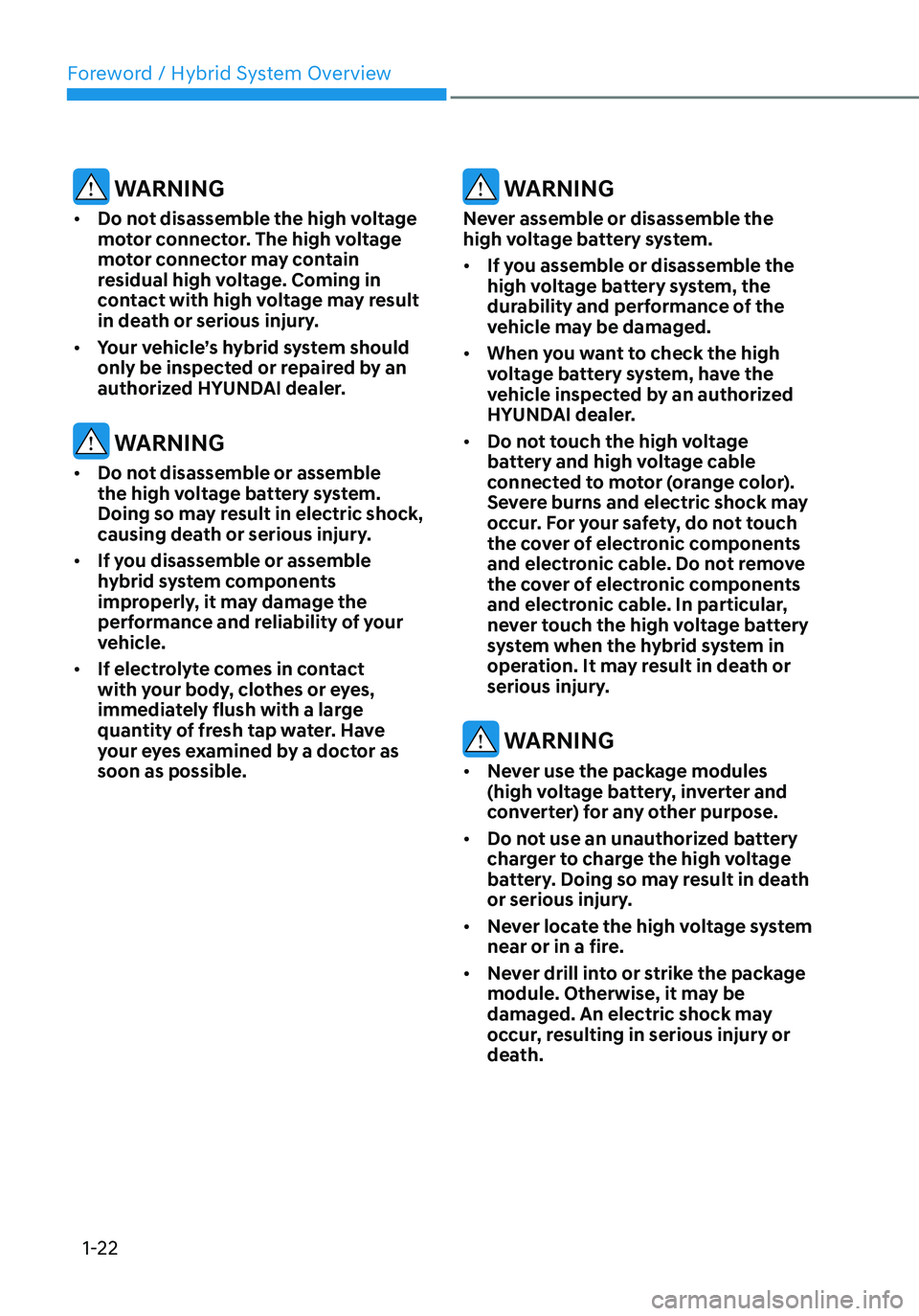
Foreword / Hybrid System Overview
1-22
WARNING
• Do not disassemble the high voltage
motor connector. The high voltage
motor connector may contain
residual high voltage. Coming in
contact with high voltage may result
in death or serious injury.
• Your vehicle’s hybrid system should
only be inspected or repaired by an
authorized HYUNDAI dealer.
WARNING
• Do not disassemble or assemble
the high voltage battery system.
Doing so may result in electric shock,
causing death or serious injury.
• If you disassemble or assemble
hybrid system components
improperly, it may damage the
performance and reliability of your
vehicle.
• If electrolyte comes in contact
with your body, clothes or eyes,
immediately flush with a large
quantity of fresh tap water. Have
your eyes examined by a doctor as
soon as possible.
WARNING
Never assemble or disassemble the
high voltage battery system.
• If you assemble or disassemble the
high voltage battery system, the
durability and performance of the
vehicle may be damaged.
• When you want to check the high
voltage battery system, have the
vehicle inspected by an authorized
HYUNDAI dealer.
• Do not touch the high voltage
battery and high voltage cable
connected to motor (orange color).
Severe burns and electric shock may
occur. For your safety, do not touch
the cover of electronic components
and electronic cable. Do not remove
the cover of electronic components
and electronic cable. In particular,
never touch the high voltage battery
system when the hybrid system in
operation. It may result in death or
serious injury.
WARNING
• Never use the package modules
(high voltage battery, inverter and
converter) for any other purpose.
• Do not use an unauthorized battery
charger to charge the high voltage
battery. Doing so may result in death
or serious injury.
• Never locate the high voltage system
near or in a fire.
• Never drill into or strike the package
module. Otherwise, it may be
damaged. An electric shock may
occur, resulting in serious injury or
death.
Page 27 of 630
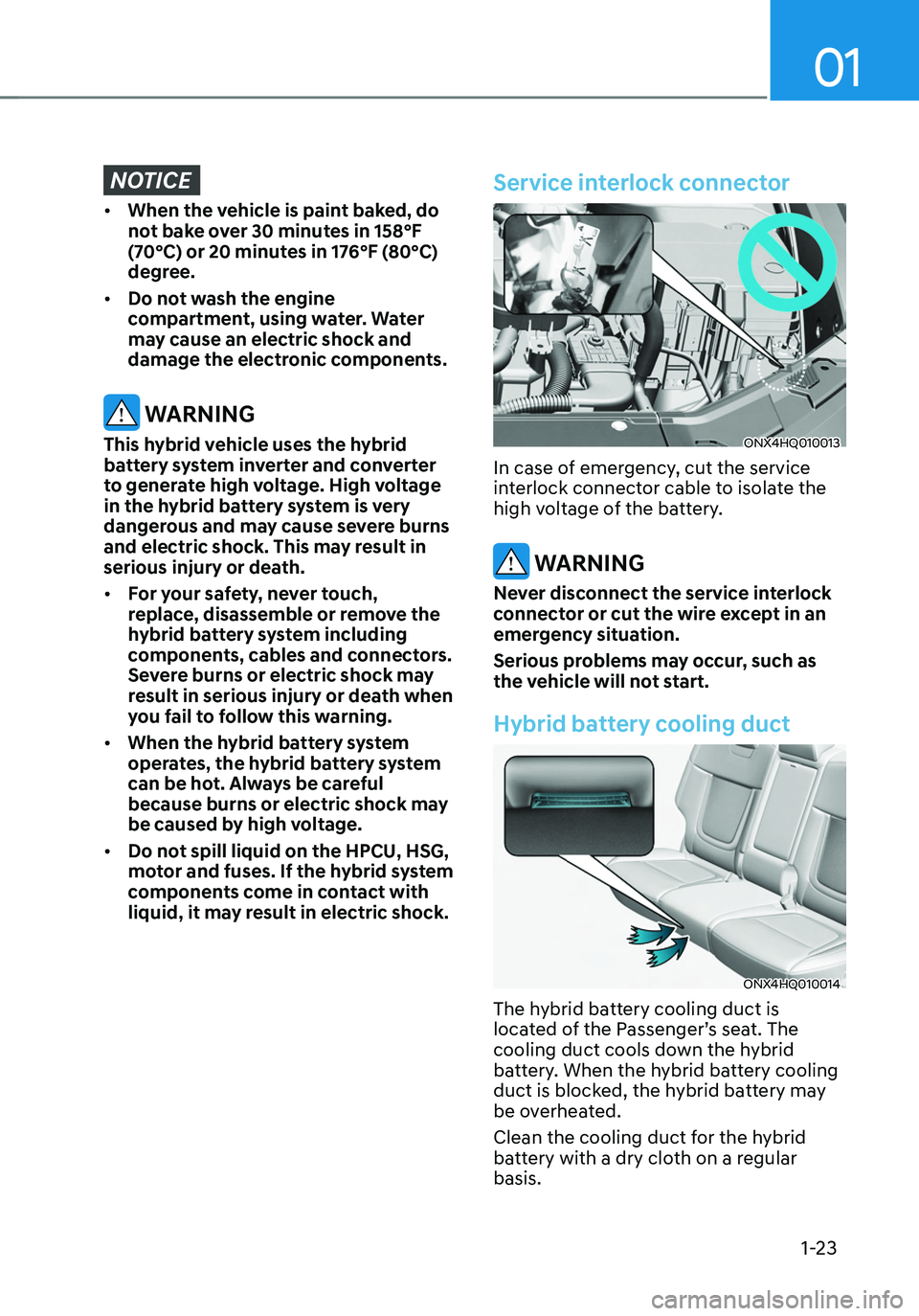
01
1-23
NOTICE
• When the vehicle is paint baked, do
not bake over 30 minutes in 158°F
(70°C) or 20 minutes in 176°F (80°C)
degree.
• Do not wash the engine
compartment, using water. Water
may cause an electric shock and
damage the electronic components.
WARNING
This hybrid vehicle uses the hybrid
battery system inverter and converter
to generate high voltage. High voltage
in the hybrid battery system is very
dangerous and may cause severe burns
and electric shock. This may result in
serious injury or death.
• For your safety, never touch,
replace, disassemble or remove the
hybrid battery system including
components, cables and connectors.
Severe burns or electric shock may
result in serious injury or death when
you fail to follow this warning.
• When the hybrid battery system
operates, the hybrid battery system
can be hot. Always be careful
because burns or electric shock may
be caused by high voltage.
• Do not spill liquid on the HPCU, HSG,
motor and fuses. If the hybrid system
components come in contact with
liquid, it may result in electric shock.
Service interlock connector
ONX4HQ010013
In case of emergency, cut the service
interlock connector cable to isolate the
high voltage of the battery.
WARNING
Never disconnect the service interlock
connector or cut the wire except in an
emergency situation.
Serious problems may occur, such as
the vehicle will not start.
Hybrid battery cooling duct
ONX4HQ010014
The hybrid battery cooling duct is
located of the Passenger’s seat. The
cooling duct cools down the hybrid
battery. When the hybrid battery cooling
duct is blocked, the hybrid battery may
be overheated.
Clean the cooling duct for the hybrid
battery with a dry cloth on a regular
basis.
Page 36 of 630
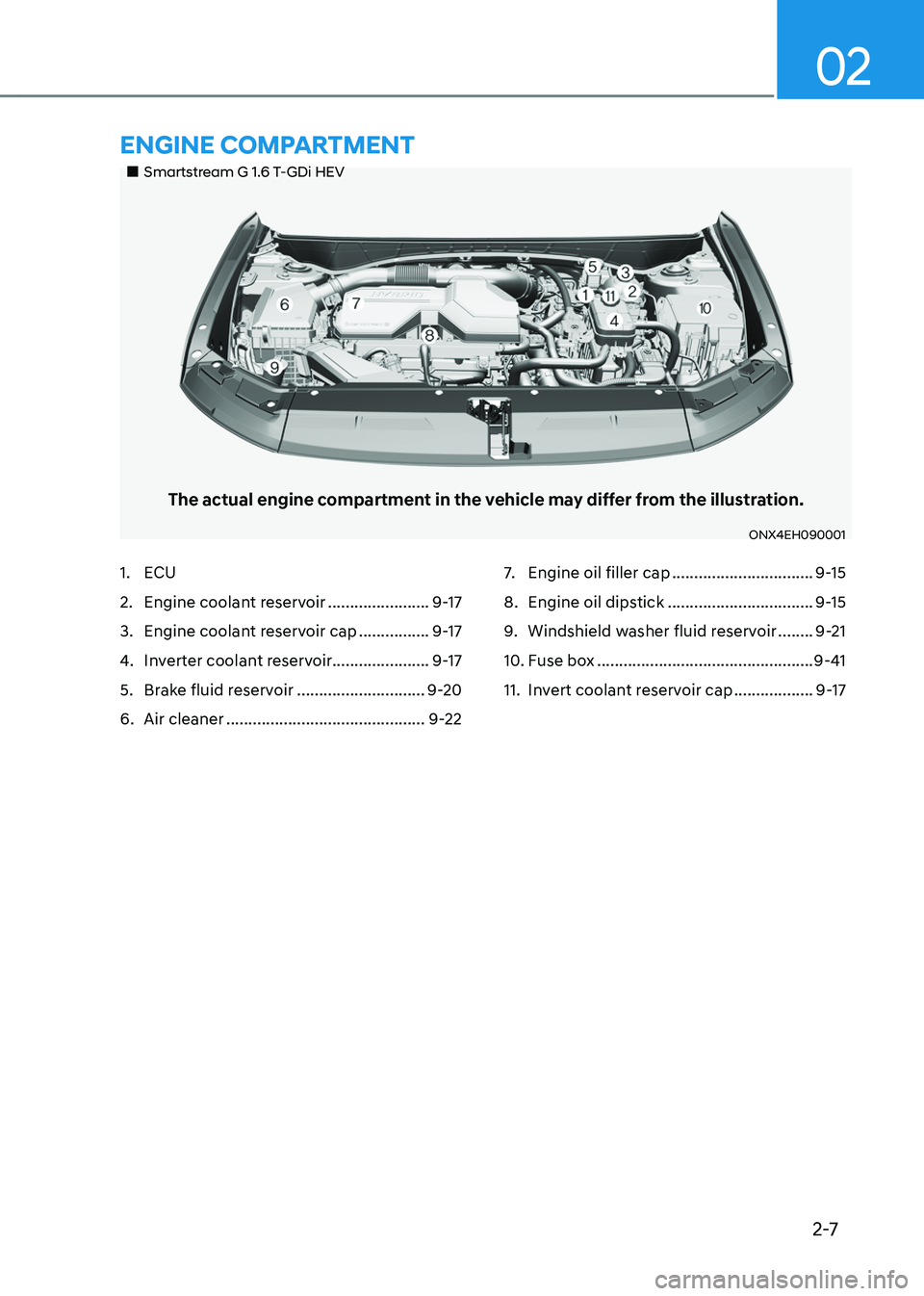
2-7
02
„„Smartstream G 1.6 T-GDi HEV
The actual engine compartment in the vehicle may differ from the illustration.
ONX4EH090001
1. ECU
2. Engine coolant reservoir .......................9-17
3. Engine coolant reservoir cap ................9-17
4. Inverter coolant reservoir......................9-17
5. Brake fluid reservoir .............................9-20
6. Air cleaner .............................................9-22
7. Engine oil filler cap ................................9-15
8. Engine oil dipstick .................................9-15
9. Windshield washer fluid reservoir ........9-21
10. Fuse box .................................................9-41
11. Invert coolant reservoir cap ..................9-17
ENGINE COMPARTMENT
Page 41 of 630
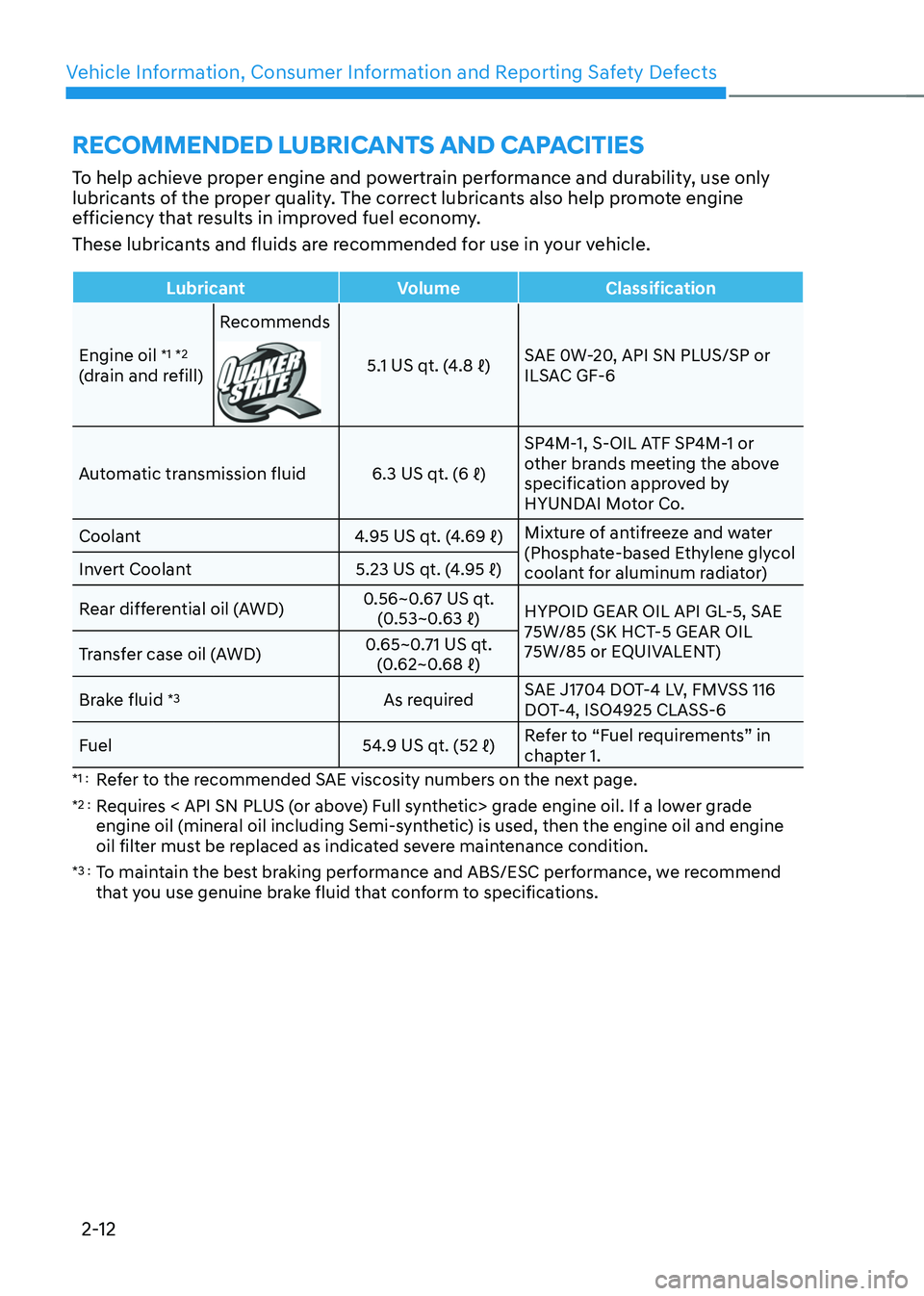
Vehicle Information, Consumer Information and Reporting Safety Defects
2-12
To help achieve proper engine and powertrain performance and durability, use only
lubricants of the proper quality. The correct lubricants also help promote engine
efficiency that results in improved fuel economy.
These lubricants and fluids are recommended for use in your vehicle.
LubricantVolumeClassification
Engine oil
*1 *2
(drain and refill) Recommends5.1 US qt. (4.8 ℓ)SAE 0W-20, API SN PLUS/SP or
ILSAC GF-6
Automatic transmission fluid6.3 US qt. (6 ℓ)
SP4M-1, S-OIL ATF SP4M-1 or
other brands meeting the above
specification approved by
HYUNDAI Motor Co.
Coolant
4.95 US qt. (4.69 ℓ)Mixture of antifreeze and water
(Phosphate-based Ethylene glycol
coolant for aluminum radiator)
Invert Coolant
5.23 US qt. (4.95 ℓ)
Rear differential oil (AWD) 0.56~0.67 US qt. (0.53~0.63 ℓ)HYPOID GEAR OIL API GL-5, SAE
75W/85 (SK HCT-5 GEAR OIL
75W/85 or EQUIVALENT)
Transfer case oil (AWD) 0.65~0.71 US qt.
(0.62~0.68 ℓ)
Brake fluid *3As required SAE J1704 DOT-4 LV, FMVSS 116
DOT-4, ISO4925 CLASS-6
Fuel
54.9 US qt. (52 ℓ)Refer to “Fuel requirements” in
chapter 1.
*1 : Refer to the recommended SAE viscosity numbers on the next page.
*2 : Requires < API SN PLUS (or above) Full synthetic> grade engine oil. If a lower grade
engine oil (mineral oil including Semi-synthetic) is used, then the engine oil and engine
oil filter must be replaced as indicated severe maintenance condition.
*3 : To maintain the best braking performance and ABS/ESC performance, we recommend
that you use genuine brake fluid that conform to specifications.
RECOMMENDED LUBRICANTS AND CAPACITIES
Page 101 of 630
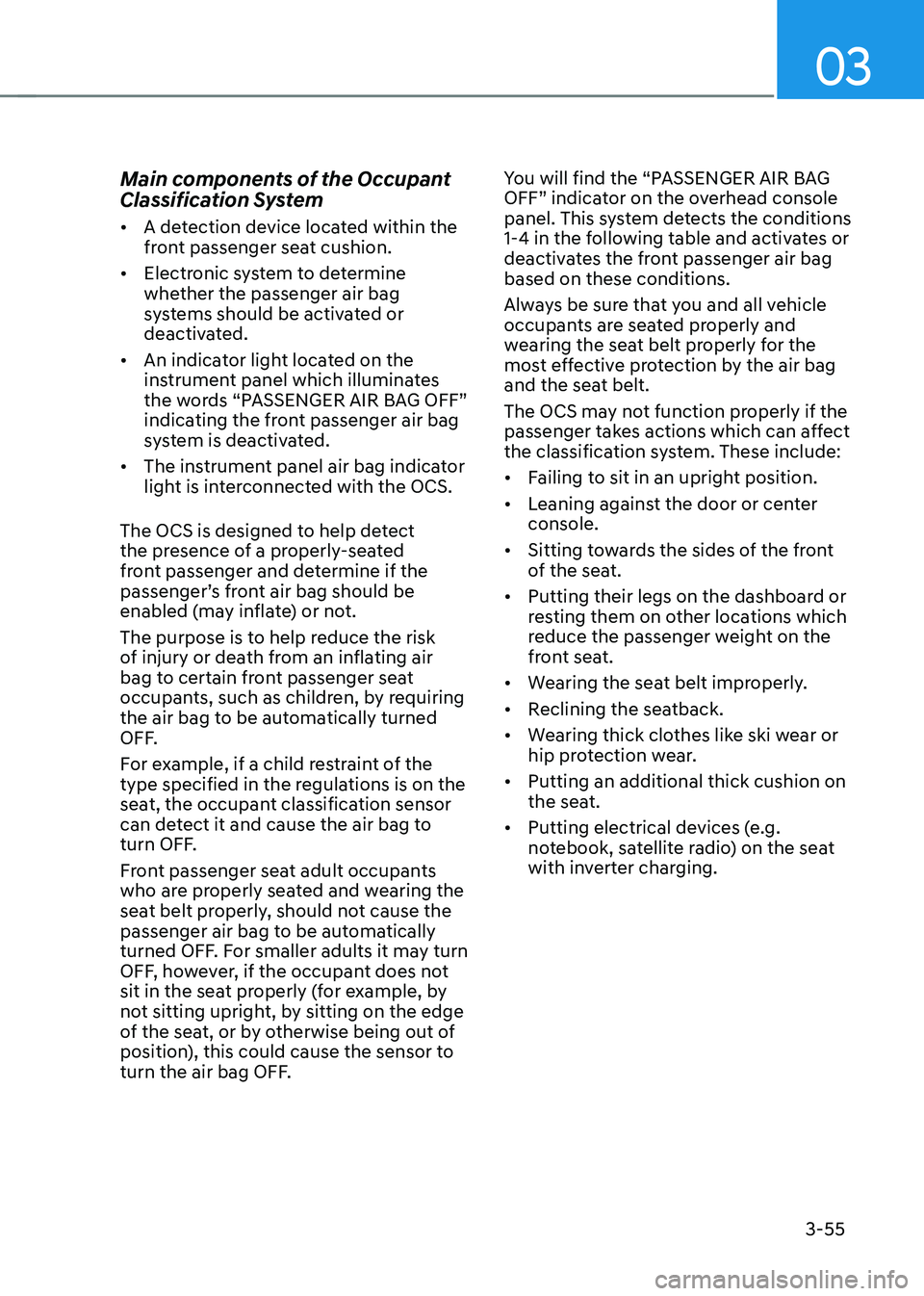
03
3-55
Main components of the Occupant
Classification System
• A detection device located within the
front passenger seat cushion.
• Electronic system to determine
whether the passenger air bag
systems should be activated or
deactivated.
• An indicator light located on the
instrument panel which illuminates
the words “PASSENGER AIR BAG OFF”
indicating the front passenger air bag
system is deactivated.
• The instrument panel air bag indicator
light is interconnected with the OCS.
The OCS is designed to help detect
the presence of a properly-seated
front passenger and determine if the
passenger’s front air bag should be
enabled (may inflate) or not.
The purpose is to help reduce the risk
of injury or death from an inflating air
bag to certain front passenger seat
occupants, such as children, by requiring
the air bag to be automatically turned
OFF.
For example, if a child restraint of the
type specified in the regulations is on the
seat, the occupant classification sensor
can detect it and cause the air bag to
turn OFF.
Front passenger seat adult occupants
who are properly seated and wearing the
seat belt properly, should not cause the
passenger air bag to be automatically
turned OFF. For smaller adults it may turn
OFF, however, if the occupant does not
sit in the seat properly (for example, by
not sitting upright, by sitting on the edge
of the seat, or by otherwise being out of
position), this could cause the sensor to
turn the air bag OFF. You will find the “PASSENGER AIR BAG
OFF” indicator on the overhead console
panel. This system detects the conditions
1-4 in the following table and activates or
deactivates the front passenger air bag
based on these conditions.
Always be sure that you and all vehicle
occupants are seated properly and
wearing the seat belt properly for the
most effective protection by the air bag
and the seat belt.
The OCS may not function properly if the
passenger takes actions which can affect
the classification system. These include:
•
Failing to sit in an upright position.
• Leaning against the door or center
console.
• Sitting towards the sides of the front
of the seat.
• Putting their legs on the dashboard or
resting them on other locations which
reduce the passenger weight on the
front seat.
• Wearing the seat belt improperly.
• Reclining the seatback.
• Wearing thick clothes like ski wear or
hip protection wear.
• Putting an additional thick cushion on
the seat.
• Putting electrical devices (e.g.
notebook, satellite radio) on the seat
with inverter charging.
Page 104 of 630
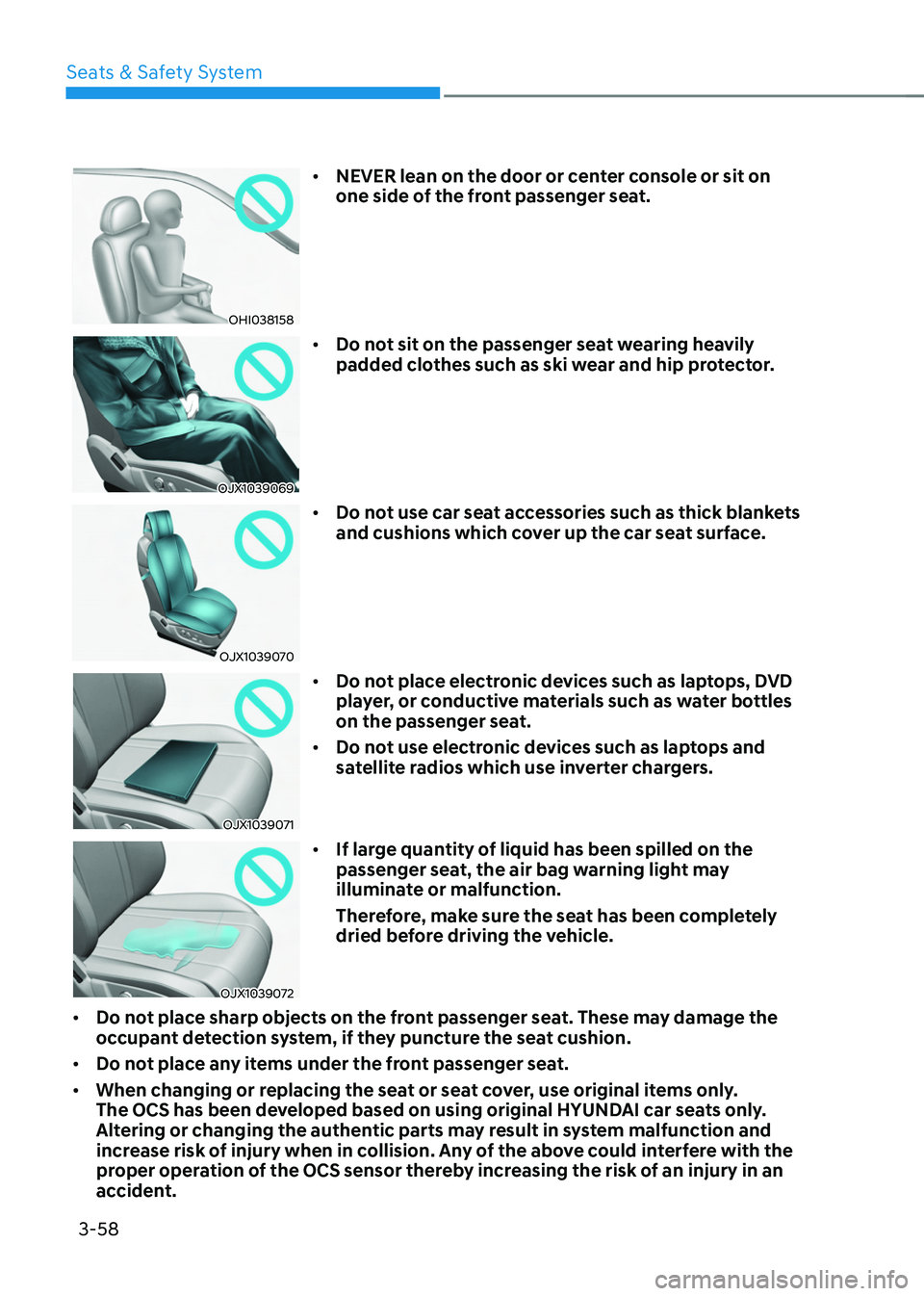
Seats & Safety System
3-58
OHI038158
• NEVER lean on the door or center console or sit on
one side of the front passenger seat.
OJX1039069
• Do not sit on the passenger seat wearing heavily
padded clothes such as ski wear and hip protector.
OJX1039070
• Do not use car seat accessories such as thick blankets
and cushions which cover up the car seat surface.
OJX1039071
• Do not place electronic devices such as laptops, DVD
player, or conductive materials such as water bottles
on the passenger seat.
• Do not use electronic devices such as laptops and
satellite radios which use inverter chargers.
OJX1039072
• If large quantity of liquid has been spilled on the
passenger seat, the air bag warning light may
illuminate or malfunction.
Therefore, make sure the seat has been completely
dried before driving the vehicle.
• Do not place sharp objects on the front passenger seat. These may damage the
occupant detection system, if they puncture the seat cushion.
• Do not place any items under the front passenger seat.
• When changing or replacing the seat or seat cover, use original items only.
The OCS has been developed based on using original HYUNDAI car seats only.
Altering or changing the authentic parts may result in system malfunction and
increase risk of injury when in collision. Any of the above could interfere with the
proper operation of the OCS sensor thereby increasing the risk of an injury in an
accident.
Page 115 of 630
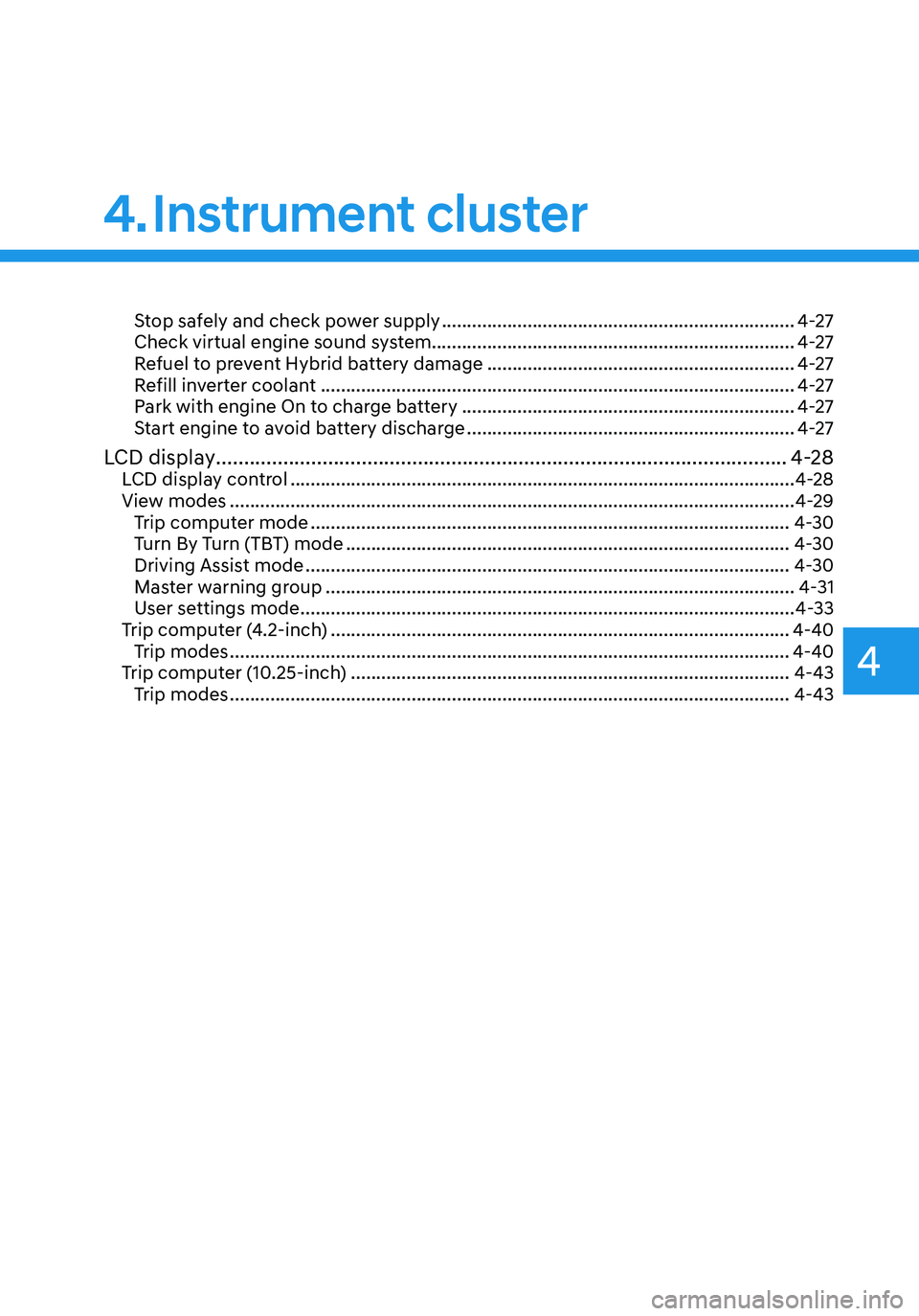
4. Instrument cluster
Stop safely and check power supply ......................................................................4-27
Check virtual engine sound system ........................................................................\
4-27
Refuel to prevent Hybrid battery damage
.............................................................4-27
Refill inverter coolant ........................................................................\
......................4-27
Park with engine On to charge battery ..................................................................4-27
Start engine to avoid battery discharge .................................................................4-27
LCD display ........................................................................\
..............................4-28LCD display control ........................................................................\
............................4-28
View modes ........................................................................\
........................................4-29
Trip computer mode ........................................................................\
.......................4-30
Turn By Turn (TBT) mode ........................................................................\
................4-30
Driving Assist mode ........................................................................\
........................4-30
Master warning group ........................................................................\
.....................4-31
User settings mode ........................................................................\
..........................4-33
Trip computer (4.2-inch) ........................................................................\
...................4-40
Trip modes ........................................................................\
.......................................4-40
Trip computer (10.25-inch) ........................................................................\
...............4-43
Trip modes ........................................................................\
.......................................4-43
4